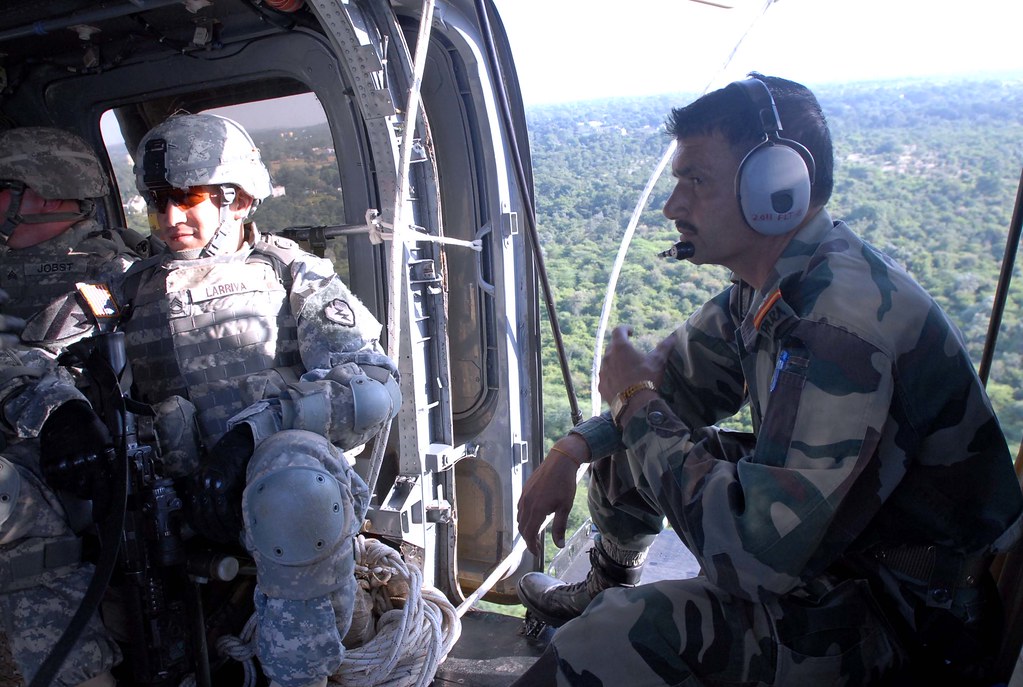Link
Trained in India, to fight in Iraq
An Indo-US wargame that ended today in Uttar Pradesh helped retrain part of an American contingent that went into action in Iraq and will be redeployed in the war-ravaged country, scaling up the bilateral exercise that was originally projected as a peace-keeping drill.
Exercise Yudh Abhyas 09 – the latest in a series of Indo-US drills that began in 2004 – involved the largest deployment of ground forces by the two countries for joint training. When the exercise began, the Indian Army officially stated that the scenario for the drill was that of joint operations for peace keeping under a United Nations’ mandate.
It was more or less expected that the US Army will begin using Indian military facilities and experience to train for operations in Iraq and Afghanistan with the wargame.
But the scale of the drill was far deeper than initially thought. Within the first five days of the two-week drill, it quickly morphed into an armoured and infantry exercise involving para-dropping and securing urban settlements simulating environments in Iraq and Afghanistan with live firing. Forces led by the US had invaded Afghanistan (2001) and Iraq (2003) without specific UN mandates.
Around 250 soldiers from the US contingent – of the 2nd squadron 14 Cavalry — pulled out of Iraq in April this year after a 15-month deployment. It is marked to re-deploy there in nine months.
Till April this year the squadron was based in Camp Taji, about 25km north of Baghdad, in a zone that is the most violent in Iraq. At least one of its soldiers, Sergeant Timothy P Martin, 27, was killed. He died in a blast from an improvised explosive device in August last year.
The drill with Indian mechanised forces in Babina – one of the Indian Army’s largest and most sophisticated training centres with a large field firing range– starts off a period of re-training for the US forces.
The exercise was witnessed by the chief of the US Army Pacific, Lt Gen Benjamin R. Mixon and India’s Director General of Military Operations (DGMO) Lt Gen A.S. Sekhon.
The trend among US-led coalition forces to use Indian military facilities to train for “Operation Iraqi Freedom” and “Operation Enduring Freedom” (Afghanistan) began in September 2007. But the drills have never involved as many soldiers, so much hardware and such massive firepower.
A unit of the British Royal Marines engaged Indian special forces in an exercise named “Himalayan Warrior” in Ladakh in September-October 2007.
The UK requested access to Indian military facilities in Ladakh and an exercise in that region because the dry desert terrain is similar to parts of Afghanistan. The British soldiers were also acclimatised at the Indian Army’s High Altitude Warfare School (HAWS) in Sonamarg.
Last October, the US army chief, General George Casey, was also escorted by Indian Army Chief, General Deepak Kapoor to Ladakh and to Indian army establishments in Kashmir and other Indian military facilities.
So far, army-level drills between the two countries involved companies (about a 100 troops in each company) or even smaller platoons. But the involvement has now been scaled-up several notches with Exercise Yudh Abhyas 09.
Just how seriously the Pentagon takes its exercises with the Indian military is indicated by the logistics that have gone into the Babina drill. It deployed 17 Strykers – the largest deployment of the multipurpose armoured vehicles outside Iraq and Afghanistan – that were shipped all the way from Schofield Barracks, Hawaii, where the unit is currently based, to Mumbai.
In Bombay, the Strykers, each weighing about 19 tonnes, were transported in sixteen-wheeler trucks to armoured corps base in Babina (that was started by the British with the acronym that stands for British Army Base in North India).
The Strykers and the US troops will now head back the same way for more training in the Mojave Desert in Southern California.
“This exercise (Yudh Abhyas 09) is a ramp-up in training, as the unit prepares for larger pre-deployment training exercises such as those at the National Training Facility in California,” a US army statementsaid.
The US army contingent was hosted by the general officer commanding the Indian Army’s 31st armoured division, Maj Gen Anil Malik. The Indians deployed the 7th Mechanised Infantry for the drill.
The scale of the exercise involving armoured units – India’s Russian-origin BMP troop-carriers, its latest T-90 tanks and Dhruv helicopters – and the US Pacific Army chief’s comments invariably stoked interest once again on possible joint operations.
“This is all about training with the Indian army, to enhance relationships so that we gain a greater understanding of each other. That’s really what this is all about,” the general said. “India has a professional army. I will go with the Indian Army anywhere, anytime,” he added.
But beyond the show of power and battlefield skills, there was also a pitch for arms sales to India. The Stryker vehicle itself was closely watched by the Indian forces. It can be configured for several tasks – offensive, reconnaissance, communications and evacuations apart from troop carrying.
A senior official of the Pentagon’s defence sales branch also escorted executives of defence companies Lockheed Martin and Raytheon to Babina for the exercise. The US contingent demonstrated the fire-and-forget Javelin anti-tank missile, at least a generation ahead of the Milans that the Indians use. India is scouting the markets to stock up on anti-tank systems because the Indian Army still trains for scenarios of armoured warfare.
Indian soldiers were not allowed to drive the Stryker but some of them took shots at dead tanks with the missile.
The sleek shoulder-fired Javelin hones into its target without having to be guided to it. It is made by Raytheon.


















